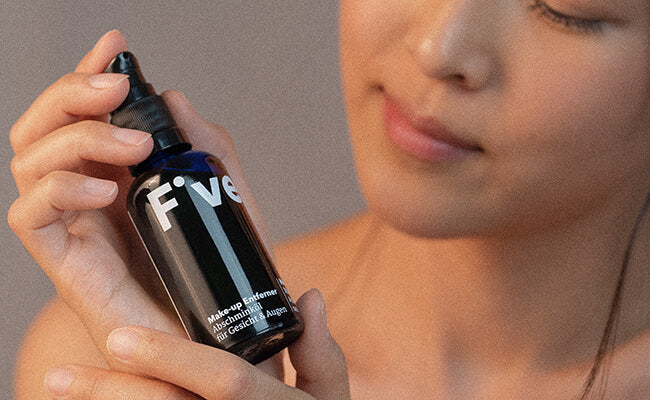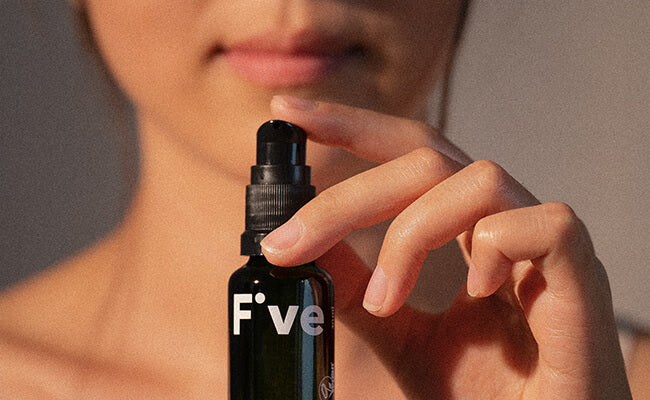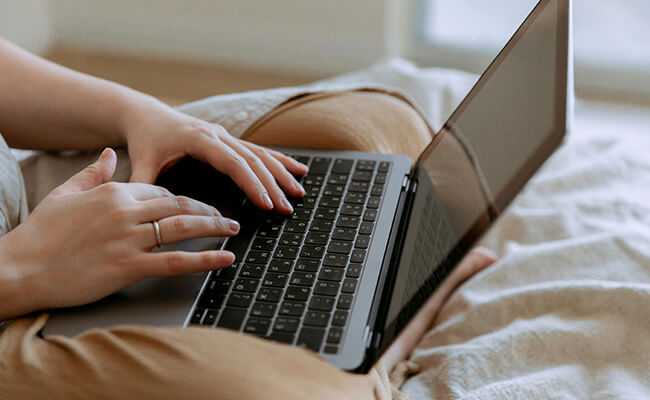Setze auf gezielte Zusatzpflege
Hast du eine Basis-Pflegeroutine gefunden, die deine Haut auf sanfte Weise wieder in Balance bringt? Dann ist der wichtigste Schritt für entspannte Haut in Harmonie bereits getan. Doch manchmal braucht deine Haut mehr. Deshalb lege ich dir ans Herz, deine Basispflege bei Bedarf mit wirkungsvoller Zusatzpflege zu ergänzen.
- Vorbeugendes Gesichtspeeling
Verwende ab der zweiten Zyklushälfte zwei bis dreimal wöchentlich abends ein mildes Peeling. Damit entfernst du sich in den Poren ansammelnden Talg und Hautschuppen und beugst Verhornungen vor, die sich zu Pickeln entwickeln können. Als Peeling eignen sich milde Enzyme, wie zum Beispiel das Enzympeeling von Santaverde.
Auch klassische Peelings mit kleinen Schleifkörnern funktionieren, sollten nicht bei entzündeten Pickeln und Hautstellen angewendet werden. Eine Anleitung für ein DIY-Peeling findest du in meinem Artikel Peeling selber machen.
- Lindernde Heilerde-Öl-Maske
Heilerde gehört definitiv in die Kategorie «Oldie but Goodie». Und sie ist (immer noch!) ein echter Geheimtipp gegen hormonelle Pickel und unreine Haut. Dafür gibt es einen guten Grund: Heilerde wirkt wie eine Art Magnet, der abgestorbene Hautzellen und überschüssiges Sebum einfach aus deinen Poren zieht.
Das zeigen sogar Studien: In einer 2012 veröffentlichten Pilotstudie liessen Wissenschaftler der Universitätsklinik Zürich und der Berliner Charité 133 Probanden mit unreiner Haut und Akne über einen Zeitraum von sechs Wochen 2 bis 3 Mal wöchentlich eine Heilerde-Maske mit Jojobaöl anwenden4.
Am Ende des Untersuchungszeitraums konnte ein Rückgang der Unreinheiten, Verfärbungen und Pusteln um 54 % Prozent gegenüber dem ursprünglichen Hautzustand beobachtet werden. Ziemlich überzeugend, oder?
Mein Tipp für eine effektive DIY-Maske gegen Akne und hormonelle Pickel: Mische einen gehäuften Esslöffel Heilerde-Pulver mit einem Teelöffel Wasser und einem Teelöffel Gesichtsöl. Lasse die Maske 15 bis 20 Minuten auf deiner Haut trocknen und entferne die Reste unter lauwarmem Wasser mit kreisenden Bewegungen. Tipp: Empfindliche und trockene Hauttypen sollte die Maske nicht ganz so lange einwirken lassen, sondern abwaschen, sobald sie eintrocknet.
Das ausgleichende FIVE Gesichtsöl für zu Unreinheiten neigende, ölige Haut enthält talgregulierendes Bio-Jojobaöl und antibakteriell wirkende Bio-Öle aus Schwarzkümmelsamen und Grapefruitschalen.
- Verwende Cremes mit Retinol
Retinol ist eine Form von Vitamin A, die gerne in der Akne-Therapie eingesetzt wird1. Denn damit schlägst du gleich mehrere Fliegen mit einer Klappe. Der Wirkstoff kurbelt die Zellregeneration an und sorgt so dafür, dass abgestorbene Hautzellen abtransportiert werden, bevor sie deine Poren verstopfen und Bakterienwachstum begünstigen können2.
Und sie können noch mehr: Ihre zellregenerierende Wirkung sorgt ganz nebenbei für weniger Falten und einen einheitlichen Hautton (bye, Pickelmale!).
Leider gibt es aber auch ein paar Haken:
-
Wendest du erstmals Retinoide an oder hast empfindliche Haut, kann es zu Trockenheit und Irritationen kommen.
-
Bist du schwanger oder planst, es bald zu werden, ist Retinol tabu. Ich empfehle in diesem Fall, dir ärztlichen Rat einzuholen.
Verwöhne dich und deine Haut mit echtem Skin & Soulfood.
Den Zusammenhang zwischen unserer Ernährung und unreiner Haut hatten wir weiter oben bereits. Statt um die Dont’s geht es hier allerdings um die Do’s. Das solltest du essen, wenn du Akne und hormonelle Pickel effektiv von innen bekämpfen möchtest:
-
Probiotika, alias Milchsäurebakterien. Sie sorgen für reine, makellose Haut und stärken das Immunsystem – in der Forschung werden die phänomenalen Effekte von Probiotika auf unsere Gesundheit heiss diskutiert. Studien zeigen, dass Probiotika sowohl das Wachstum des Aknebakteriums Propionibacterium acnes abblocken, als auch hemmend auf den Insulinähnlichen Wachstumsfaktor IGF-1 wirken können, der als Akne-Trigger gilt5.
Gute Probiotika-Quellen sind fermentierte Lebensmittel wie saure Gurken und Sauerkraut, sowie Apfelessig und Kombucha.
-
Präbiotika. Zusammen mit Probiotika bilden sie ein perfektes Dream-Team für schöne Haut von innen. Denn Präbiotika wirken wie ein Dünger für ihre bessere Hälfte. Um optimal von den gesundheitsfördernden Effekten guter Probiotika-Bakterien zu profitieren, solltest du die beiden deshalb gemeinsam in deinen Speiseplan integrieren.
Gute Präbiotika-Quellen sind Zwiebeln, Knoblauch und Spargel, sowie Obst wie Äpfel, Bananen und Birnen.
-
Komplexe Kohlenhydrate. Auch bekannt als langsame Kohlenhydrate, haben sie vor allem eine ganz tolle Eigenschaft: Sie bestehen aus langen Molekülketten. Um diese aufzuspalten und zu verwerten, braucht unser Körper Zeit. Das ist gut für unseren Blutzuckerspiegel. Denn der steigt nach dem Verzehr komplexer Kohlenhydrate nur langsam und flach an. Anders ist das, wenn wir einfache Kohlenhydrate (Pasta, Mehl, Süssigkeiten und Fast Food) zu uns nehmen.
Sie lösen im Körper eine ungesunde Kettenreaktion aus. Einfache Kohlenhydrate führen zu einem Anstieg der Level von Insulin und dem Insulinähnlichen Wachstumsfaktor IGF-16. Dieser regt die Bildung von bestimmten Hormonen (den Androgenen) an, die wiederum die Talgproduktion stimulieren – so können hormonelle Pickel entstehen.
Gute Quellen für komplexe Kohlenhydrate sind brauner Reis, Quinoa, Kartoffeln, Haferflocken, Hülsenfrüchte und Vollkornbrot.
Noch mehr Tipps zur richtigen Ernährung für reine Haut bekommst du in meinem Artikel Ernährung gegen Pickel: So reduzierst du Unreinheiten.
Fazit: Mit der richtigen Strategie kannst du hormonelle Pickel effektiv bekämpfen!
In diesem Artikel habe ich dir gezeigt, was hormonelle Pickel sind, woran du sie erkennen kannst und was wirklich gegen hormonelle Akne im Erwachsenenalter hilft. Zum Abschluss möchte ich mir und dir ans Herz legen, uns so anzunehmen, wie wir sind. Jeder von uns hat Makel, eine perfekte Haut gibt es nicht. Gönne dir regelmässig bewusste Self-Care, tu’ das, was dich glücklich macht und integriere hautverwöhnende Pflegeprodukte mit lindernden Inhaltsstoffen in deine tägliche Skincare.
Hier kannst du das FIVE Gesichtsserum mit kostbarem Rosenwasser aus Damaszener Bio-Rosen und das antibakteriell wirkende FIVE Gesichtsöl Balance entdecken.
Ich wünsche dir alles Gute!
Anna





